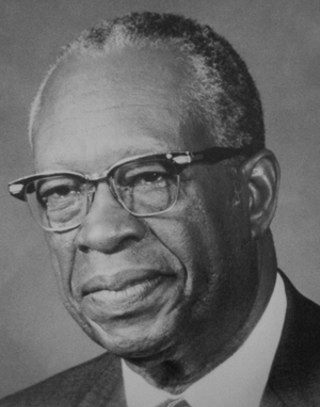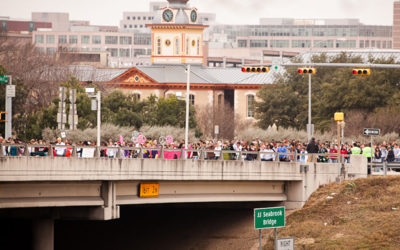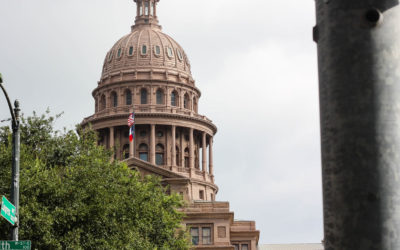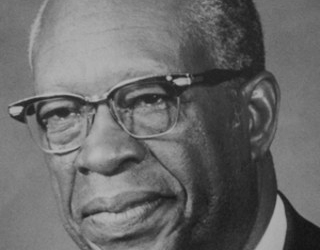Bridging between
East and West Austin
The Austin grid is defined principally by the Colorado river running east-west, and Interstate-35 running north-south. Today and for the last sixty years, I-35 is that physical dividing line between East and West Austin. The new interstate would flow under a large bridge supporting a major east-west corridor–19th Street–that connected the University of Texas and Downtown to all points east. Today, that 19th Street corridor is named Martin Luther King Jr. Blvd.
This page tells the story of how 19th Street became Martin Luther King Blvd., and how that unnamed bridge became the J.J. Seabrook bridge, a symbol of the struggle between East and West Austin.
A bridge was needed in 1975. A bridge is still needed today.
Keep Up With Bob
JJ Seabrook Raises His Hand
In 1975, eight years before I first set foot in Austin, a debate raged in the city council about renaming one of the larger streets, 19th Street, after civil rights leader Rev. Martin Luther King Jr. who was assassinated in 1968. 19th Street ran east-west from the University and the prosperous white side of town, into the heart of east Austin, the predominantly black part of town.
When a group of young black students in east Austin approached the city council with the idea to rename 19th Street to honor the black hero of the civil rights movement, the council approved the change. But quickly the downtown businessmen heard about it, and resisted. The strongest pushback was from…
Related Articles About East and West Austin
The man behind MLK Blvd (KXAN)
This story by local TV news channel KXAN Austin was published in January 2011, on Martin Luther King's birthday, the day that we all marched over the J.J. Seabrook Bridge for the very first time. AUSTIN (KXAN) - In honor of one civil rights leader, thousands...
How I Got Involved
An excerpt from : O’Dell, Bob, Five Years with Orthodox Jews, (Jerusalem, Israel: Root Source Press, 2020), 290-293. Twenty-seven years after the death of J.J. Seabrook, in 2010, my wife and I attended a fund-raising dinner for the Austin House of Prayer. There...
The JJ Seabrook Story
An excerpt from : O’Dell, Bob, Five Years with Orthodox Jews, (Jerusalem, Israel: Root Source Press, 2020), 290-291. In 1975, eight years before I first set foot in Austin, a debate raged in the city council about renaming one of the larger streets, 19th...
Why was the Seabrook story almost forgotten?
Pastor and educator, J.J. Seabrook was known and respected in the city. He was President of Huston-Tillotson College (now University). He was respected in City Hall. That he was almost forgotten has, I believe, two reasons. First, he and his wife were childless with no relatives living here. But secondly, he was remembered, but he was remembered in East Austin where an entire neighborhood bears his name.
The significance of the JJ Seabrook Bridge in 2010 was not that it was his first remembrance, but that it was a remembrance initiated from West Austin. And every time I drive on I-35, I think about Dr. JJ Seabrook’s name has now been forever tied with Dr. Martin Luther King, Jr. Both men pleaded for unity, for erasing the dividing lines. How appropriate then that the drivers who view their names are not driving in East or West Austin. They drive right down that middle line.
Words of Remembrance
For the JJ Seabrook Project of 2010
Geno Hildebrandt
Symbols are important. There is no more fitting symbol for Dr. J.J. Seabrook’s life and ministry than placing his name on the most important bridge across the City of Austin’s racial dividing line of IH-35 in the center of town. It was largely Dr. Seabrook’s personal sacrifice that convicted the all-white, 1975 Austin city council to rename 19th street, which stretches from downtown to the city’s largely-black east side, after the Rev. Dr. Martin Luther King, Jr.
by Geno Hildebrandt, Senior Pastor of Austin’s Hope Chapel
Thomas Cogdell
The Seabrook initiative was my first serious racial reconciliation initiative, and I believe it was Bob’s first foray into this type of work, at all. So we didn’t really know what we were doing! But we were fortunate to be surrounded by good partners who enabled the project to not only reach its goal but exceed our expectations.
Thomas Cogdell,
Austin House of Prayer (2004 – 2013)
Get in Touch With Bob O’Dell
Have questions or comments for Bob? Feel free to fill out the form below and he will personally get back to you by email



